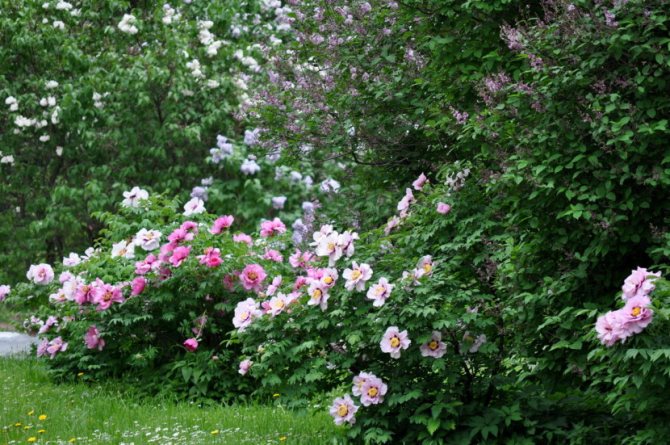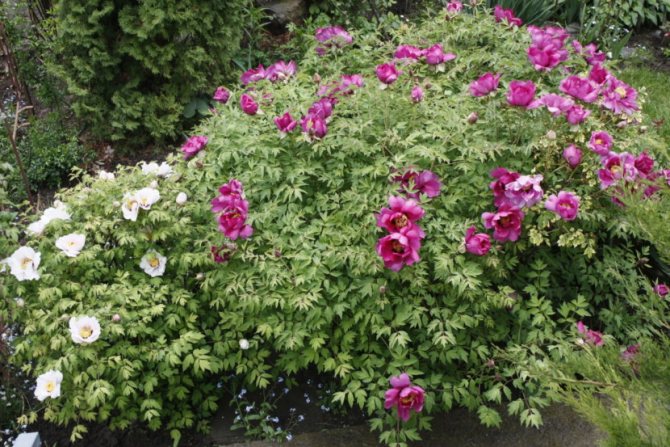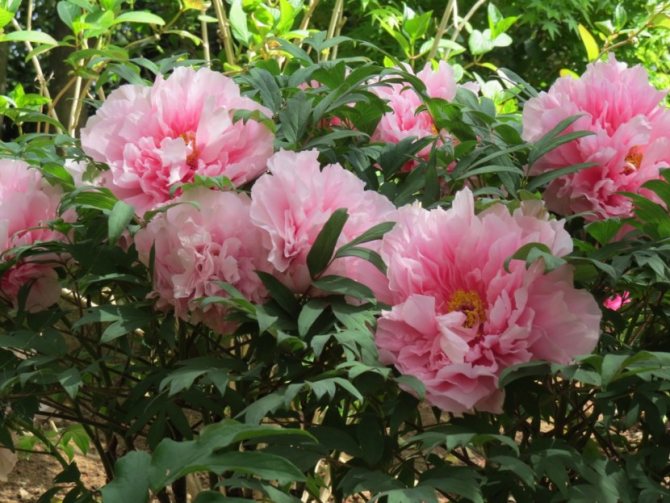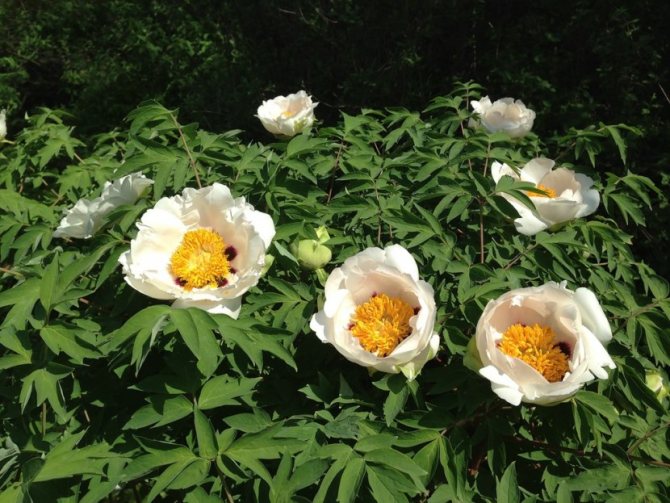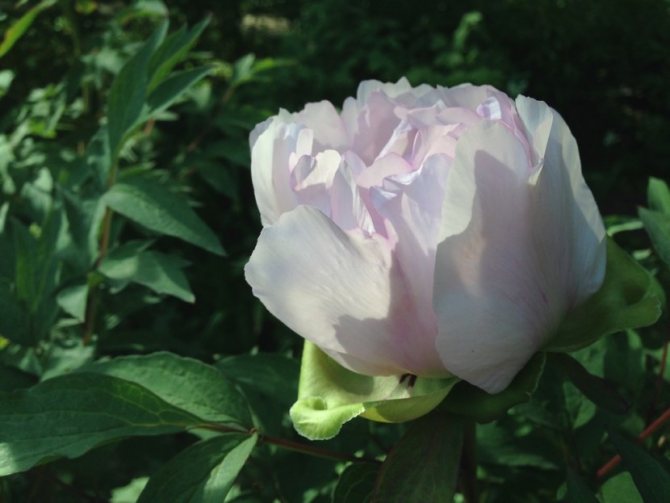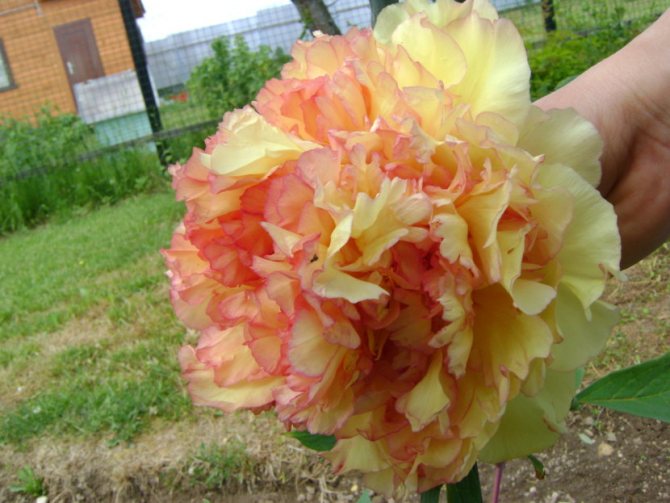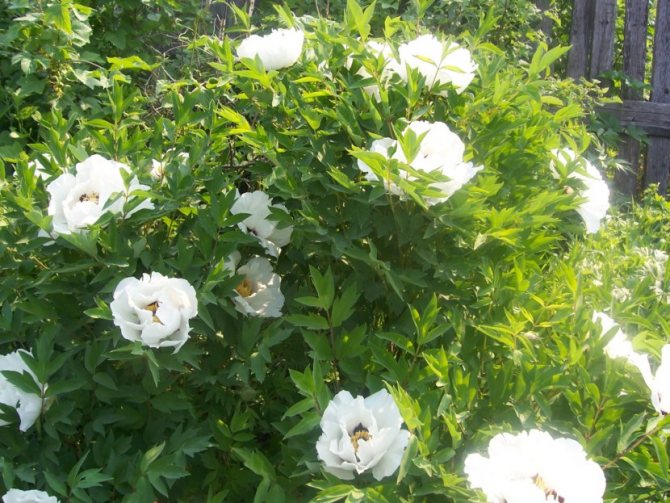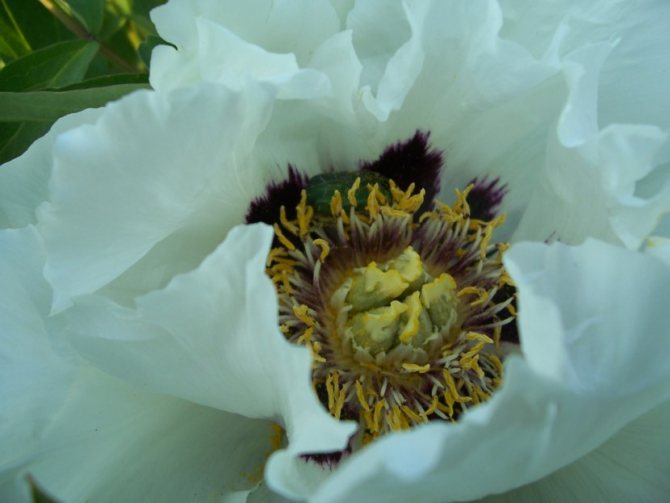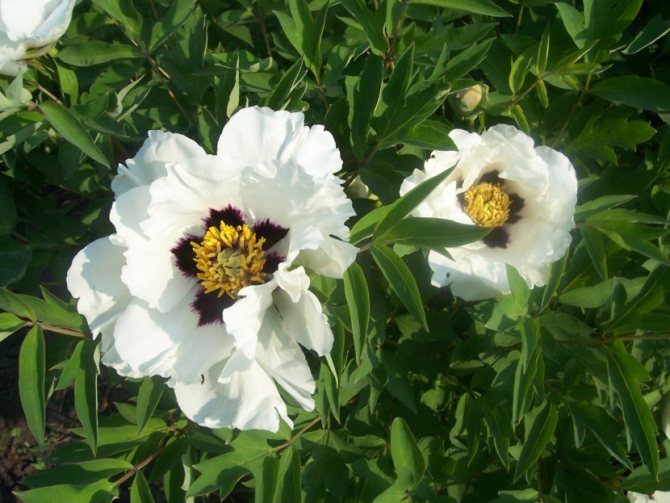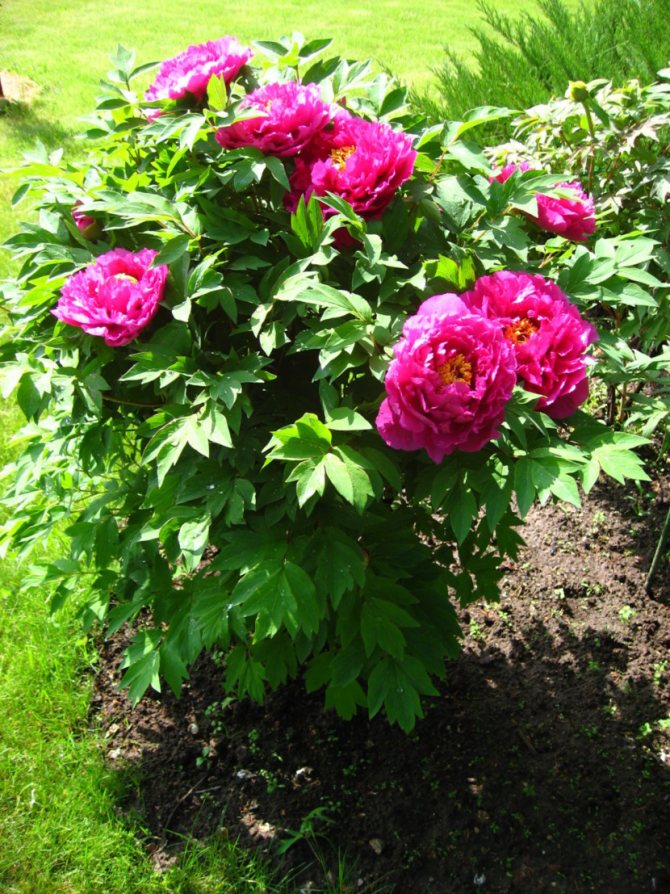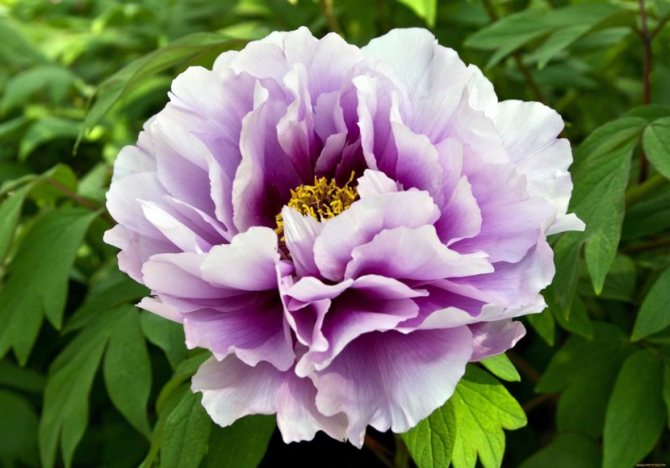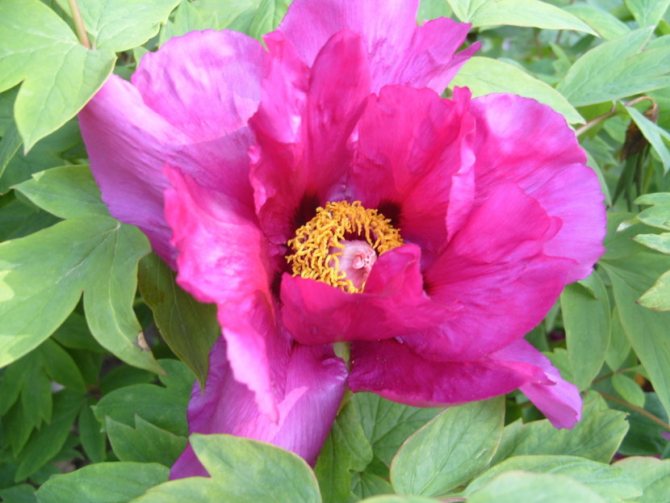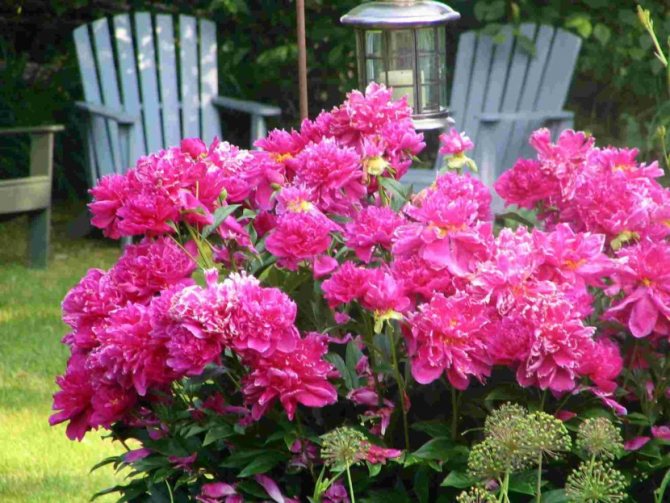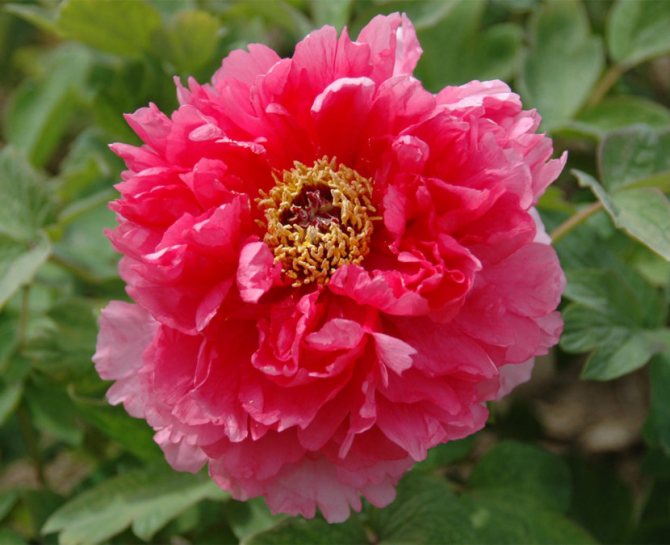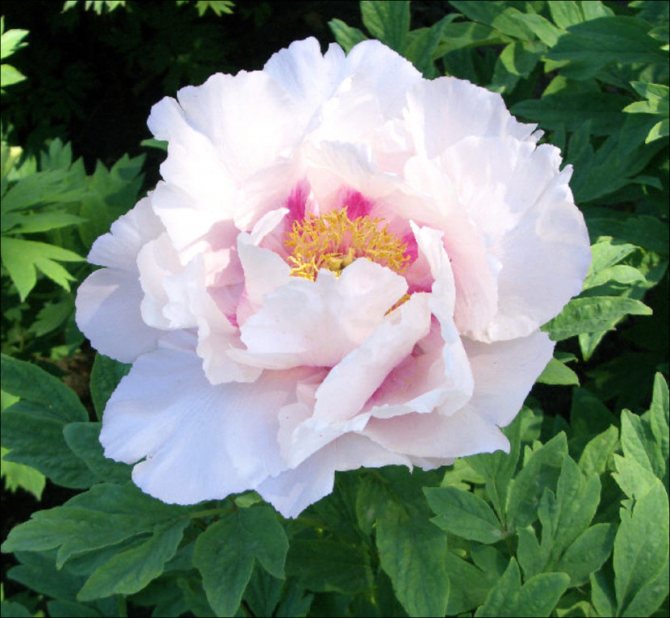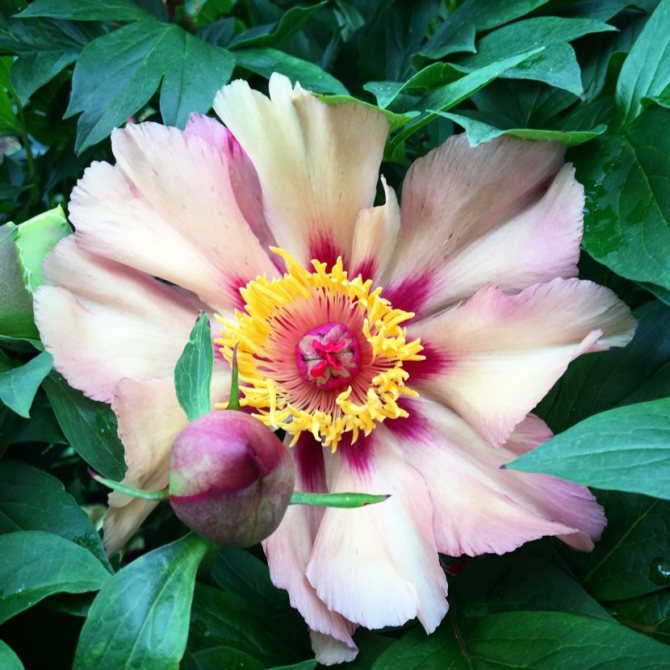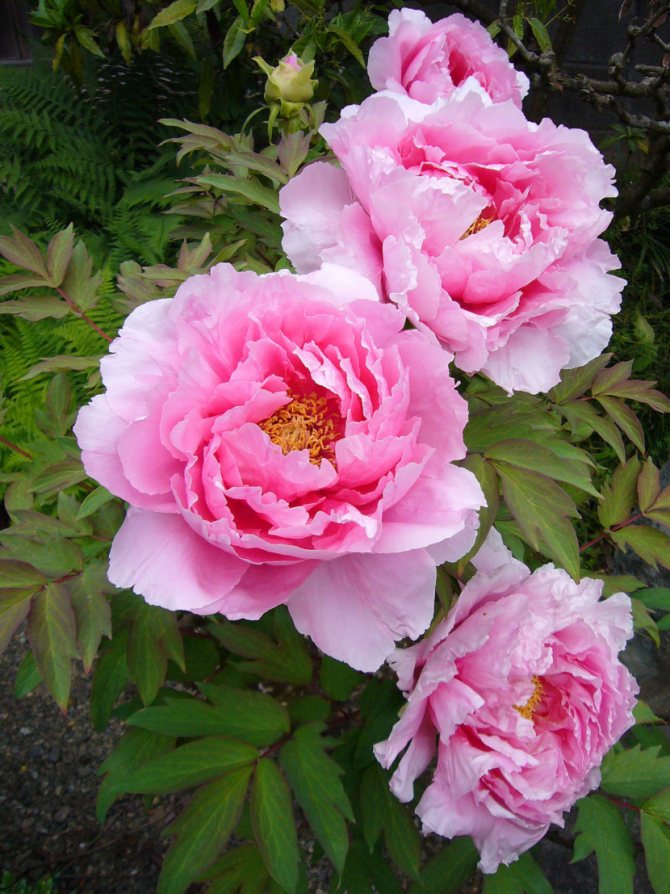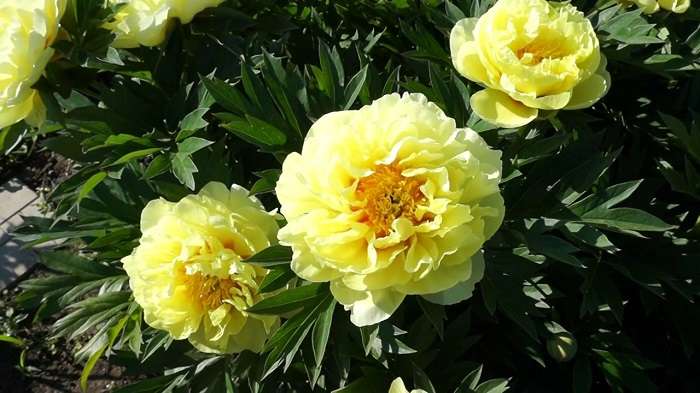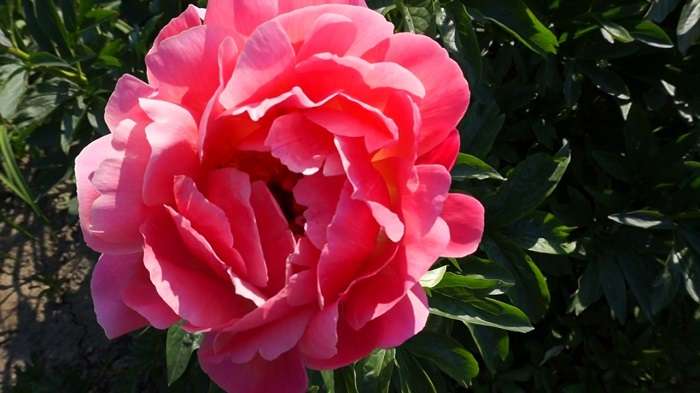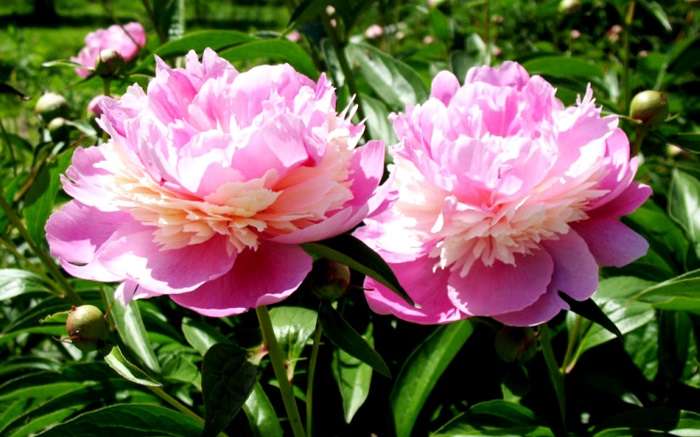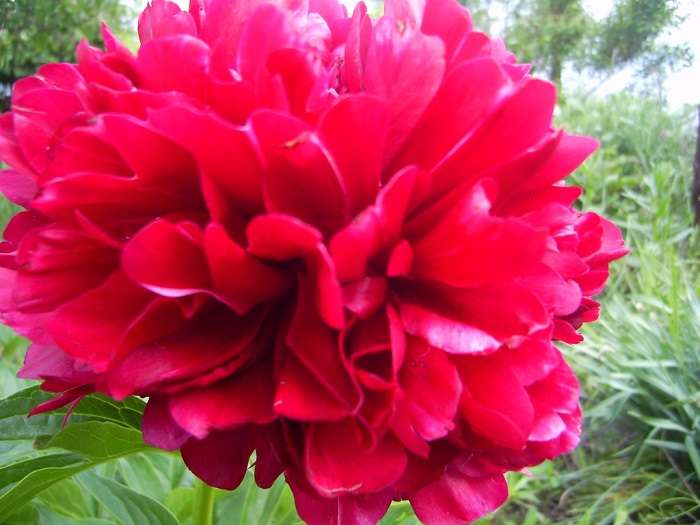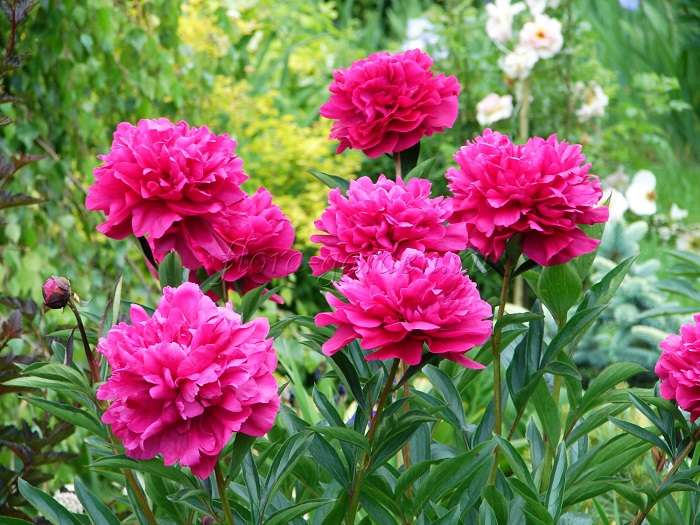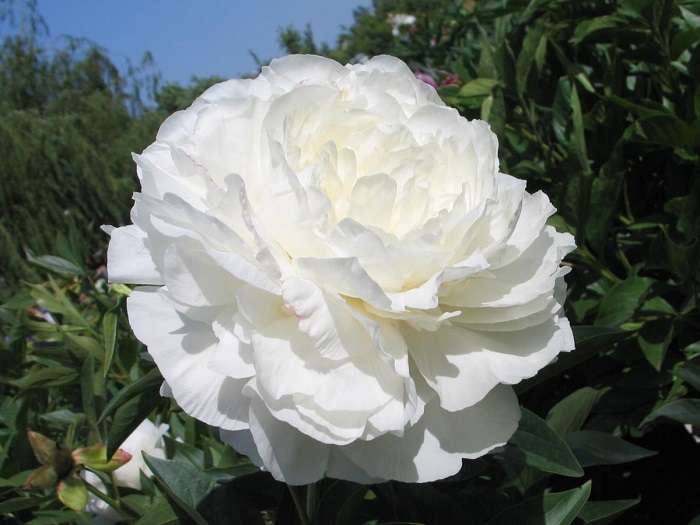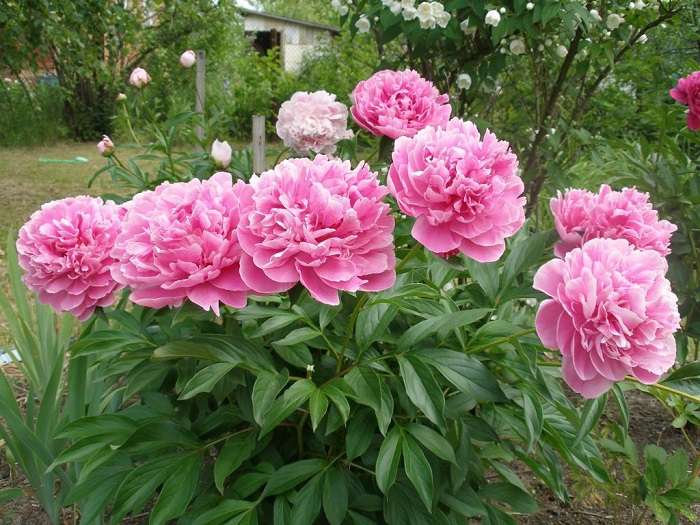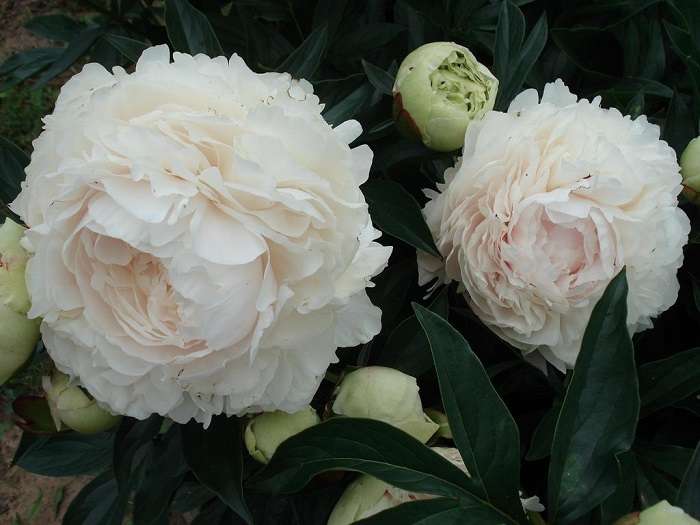Description of tree peony
This is an amazing flower. Similar to a shrub, it blooms and grows up to 2 m in height. Shrub peony trees are long-livers and can grow on the landscape for several decades. The giant flower, like an ordinary tree, sheds its leaves in the fall, wintering is well tolerated.
The remaining shoots harden and become strong.
But in the warm season, lush, many-leaved buds of impressive size begin to bloom, with a diameter of about 20-23 cm. The flowers emit a wonderful aroma. On one bush alone, a huge number of them can grow.
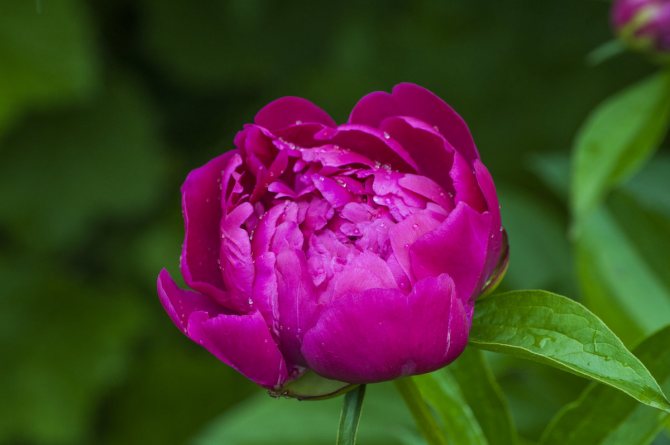
The most common petal colors are:
- Dark crimson;
- Pink;
- Red.
Peony creates a beautiful view in the garden, in the country. You can see photos of how best to decorate the landscape. Also flowers are white, pale pink, lilac, lilac. Other unexpected shades, such as purple, are currently being produced.
Peony flowers: what types are there and their differences
The genus of peonies has about 50 species. They grow everywhere: in East Asia, Europe, North Africa and the American continent. There are also wild species growing in the Caucasus, Siberia, Crimea, Ukraine and the Far East.
The flower got its name in honor of the Greek god of health - Peony. Peonies were used in medicine as early as the 1st century AD. In Russia, these flowers were first grown in pharmaceutical gardens, and then they were imported from abroad as ornamental plants.
According to biological and morphological characteristics, peonies are divided into:
- Tree-like
- Herbaceous
The aerial part of the tree-like ones is preserved in the form of lignified gray shoots, 80 - 90 cm high. And in the herbaceous, the aerial part dies off annually.
Varietal herbaceous peonies according to the structure of the flower are combined into 5 garden groups:
- Non-double
- Terry
- Semi-double
- Anemoid
- Japanese
By the timing of flowering, peonies are divided into:
- early
- average
- late
Early varieties of peony flowering
In Belarus, for example, early varieties of herbaceous peonies bloom in early June. These include the most decorative ones, such as the "Adolph Russo" variety, dark red, semi-double, with a flower diameter of up to 12 cm (bush height up to 140 cm),
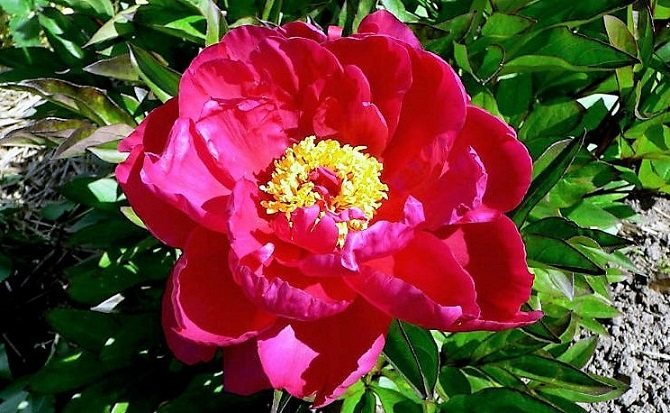

variety "Le Sin" is terry, white, with a creamy shade, with a flower diameter of up to 13 cm (plant height 70 - 80 cm)
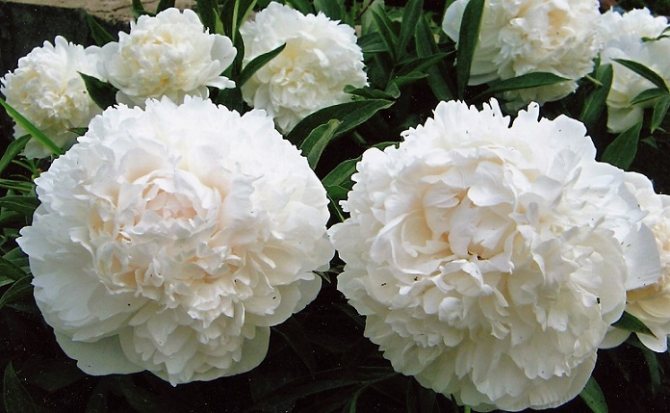

variety "Edulis Superba" deep pink, double, with a flower diameter of up to 10 cm, very aromatic (bush height 110 - 120 cm)
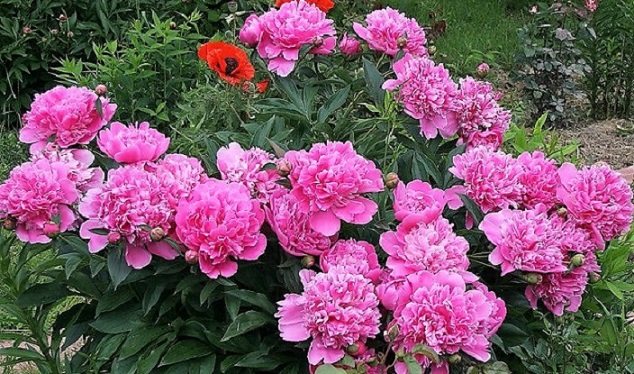

variety "Dr. H. Barnsby" double, wine-red, profusely blooming, tall, with a flower diameter of up to 13 cm
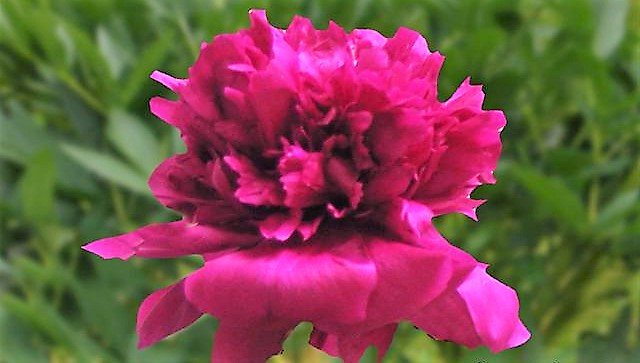

grade "Festima Maxima" is terry, but has a mediocre smell
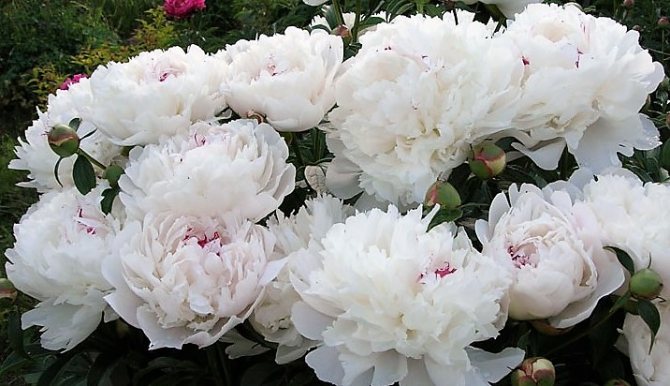

Average varieties of flowering peonies
Varieties with average flowering periods (second decade of June) include: variety "Bayadera" white, double, very large up to 14 cm, fragrant (bush height 110 - 120 cm)
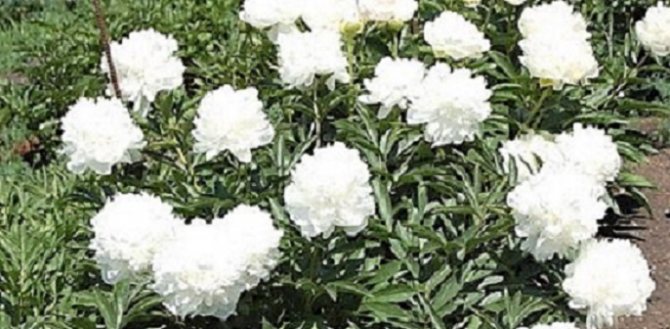

The Longfell variety is bright red, double, with a flower diameter of up to 11 cm (bush height 60 - 90 cm)
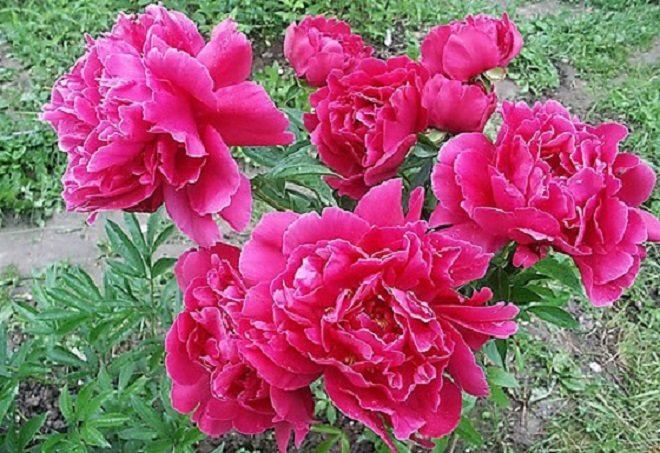

variety "Germaine Bigot" terry, pale pink, large up to 13 cm, profusely blooming (bush height 70 - 90 cm)
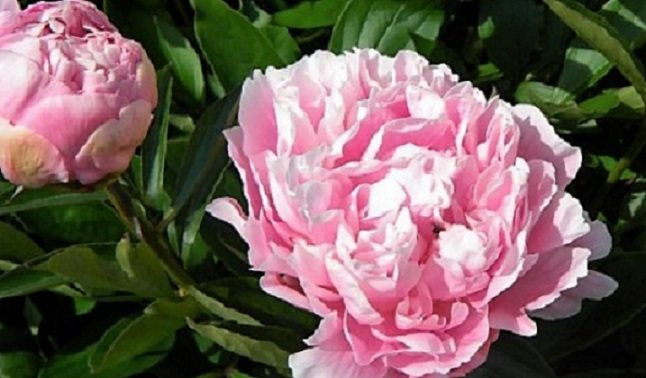

the variety "Arkady Gaidar" is terry with large bright crimson flowers, there can be 3 flowers on one stem and you will have a ready-made bouquet
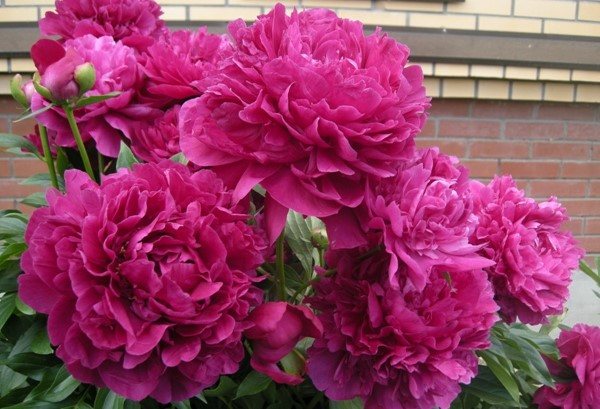

Late varieties of flowering peonies
Late-flowering peonies include varieties with flowering dates at the end of June. This includes varieties such as "Anshantress" white with a lemon tint, terry, very large (bush height up to 70 - 90 cm)


variety "Marchelle Mac Magon" terry, deeply dark red, with a flower diameter of up to 12 cm (bush height 70 - 90 cm)
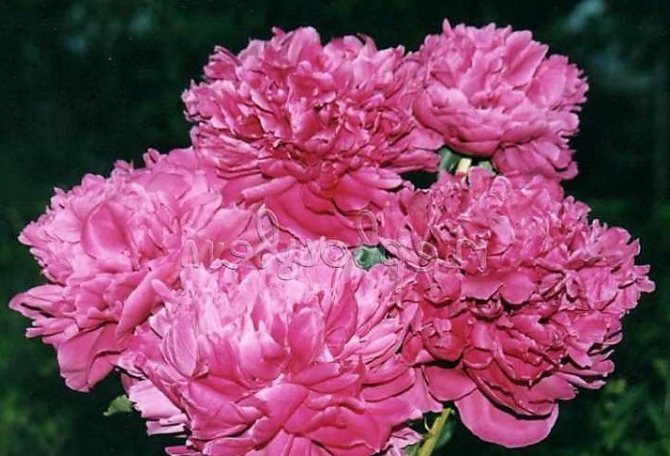

variety "Sarah Bernhardt" intense pink, with a flower diameter of up to 15 cm, abundantly blooming (bush height 90 - 100 cm)


Peonies are used for planting singly or in groups against the background of a lawn in combination with flowering shrubs or other low perennials.
Collect varieties of different flowering periods in plantings and you will get a continuous flowering effect of peonies for 40 - 45 days.
Many people refuse these luxurious plants because their branches droop low under the weight of the flowers. But who is stopping you from placing supports under them? It's as simple as that.
Varieties of varieties
There is not only domestic culture, but also a wild mountain view. Scientifically, the tree peony is from the peony family, the Latin name is Paeonia suffruticosa. There is a version that the word name is derived from the Greek "paionis", which means healing.
Varieties of varieties:
- Peony (peony) tree called Mrs. Hansu Moudan.
- Chinese hybrid bred - Jonjan Mudan.
- Yellow crown (Paeonia Yellow Crown) - herbaceous and tree species in symbiosis.
- Coral altar.
The latter has a variegated red-white color. The petals are also of an unusual carved shape. The leaves are feathery, dark green in color. They complement the overall beautiful appearance of the plant. The tree-like peony is native to China.


It was believed that this flower is a symbol of longevity, it was loved and revered.
The Chinese believed that it protects against evil forces and spirits. The plant spread thanks to traveling monks who visited monasteries in different countries. In Russia, the peony takes root well, it does not belong to picky plants. However, before planting, it is worth preparing, learning how to care for a flower.
Origin story
China is considered to be the native state for this flower. In the southwestern part of the country, it is often found in the wild in the forests located at the foot of the mountains. Initially, the peony was only used in medicine. Over time, by crossing, Chinese gardeners developed an ornamental plant with large fragrant flowers.
Around 1,500 years ago, the tree-like peony adorned the imperial gardens. Later, the plant settled in the estates of rich and noble people. It is noteworthy that ordinary people did not have the right to grow this flower. For many years, the peony was considered a sign of nobility and high position in society.
Care and cultivation
Peony, like many flowers, loves sunlight. You need to choose an area open to light. Partial shade is allowed for several hours, but otherwise the flowers may look defective. Also, peonies should not be planted near houses, buildings, other shrubs and trees.
You should not plant a peony in a place that is too watery. The soil should be moderately moist, loamy type. The roots grow deep into the soil, so it needs to be well cultivated.
Tree peony care is the same as for other plants. It is necessary to remove weeds, loosen the soil. Be sure to water regularly. For the dry summer season, an irrigation system is required. It is not necessary to water the plant in autumn. But, it all depends on the climate. In order for the peony to develop well, it must be properly divided.
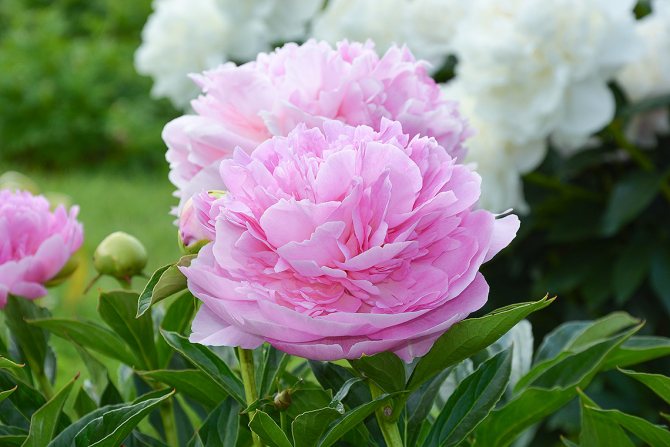

Reproduction of a tree peony, ways:
- Cuttings;
- Division;
- Layers;
- Vaccination.
The easiest way is division. Let's analyze it step by step. Carefully dig out the rhizome, digging in the bush in a circle. Divide each part of the root by 2 more, remove the rotten old stems.Dig holes and plant parts of the root about 3-5 cm below the ground.
Rules for planting a bush in the garden
Before planting a plant, you need to find a suitable place. It is best to plant the bush on a small hill in an unshaded area away from dense, tall vegetation and outbuildings. With this placement, the plant will receive a sufficient amount of sunlight.
Loamy soil will be the most suitable habitat for a peony. In the event that clay soil predominates on the territory, it should be filled with sand and enriched with organic fertilizers. Sod land, clay and peat are introduced into the sandy soil.
Reference! The more correctly the planting site is chosen, the longer the life of the plant will be.
Table 2. Step-by-step instructions for planting a tree peony
| Step | Act |
| Seat selection | Find a sunny area without drafts |
| Pit preparation | Dig a hole 70 cm in diameter and with the same depth |
| Drainage | Line the bottom with drainage with a layer of 20-40 cm |
| Land | Pour earth on the drainage |
| Seedling | Place the roots on top of the slide |
| Water | Fill the hole with water to allow the roots to spread freely |
| Landing | Cover the roots with earth |
| Completion | Compact the ground slightly, add more soil if necessary |


Landing scheme
Bushes that have a native root system are covered with earth to the place where it was planted during cultivation. Seedlings with clothespins are buried so that the grafting itself is hidden by the soil by 10-15 cm.


Root location
The gap between peony bushes should ideally be 1.5-2 m. The optimal period for transplanting is from the second week of August to the last September. Saplings can be planted in early spring. The roots of the bush develop best in cool conditions.
Reference! The first flowering after transplantation can occur only after 2-4 years.
Video - Tree peony: planting
Peony Botan characteristics
Peony Botan is a description of a plant in a scientific biological language. Refers to perennial herbs. This is achieved through tuberous roots. Flowers are bisexual with double perianth. Accumulating double stamens form a dense circle. The flower has 3 to 5 pistils. They are curved and have a stigma.
Leaves:
- Cirrus;
- Triplets;
- Closer to a small flower;
- Closer to the root - they form sepals.
The varieties differ in mutating stamens, bud color, and leaf shape. In the early 20th century, the peony was attributed to the buttercup family. When planting, you need to lower the seedling into the soil as carefully as possible so as not to break off the plant. To do this, you do not need to compact the earth, but lightly sprinkle it.
At the end of the process, water the soil with peat and an admixture of natural fertilizers.
When the time comes to the cold season, the faded buds need to be cut off. For the winter, for more confidence, it is better to cover the flower with foil. Plants that are protected from the cold will grow much better.
Thin-leaved or narrow-leaved peony
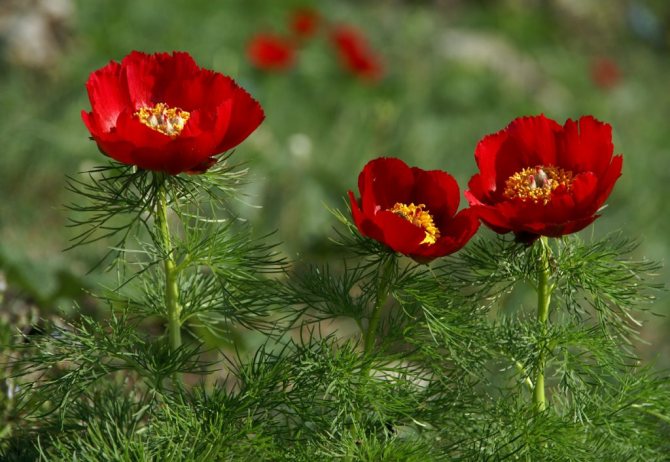

The first mention of it dates back to the beginning of the 18th century. A rare species included in the Red Data Book, despite a fairly long history of cultivation. A distinctive feature of this variety is the peculiar shape of the leaves.
The flowering dates are early, most often the beginning or mid-May. Flowering lasts up to 2.5 weeks. After flowering, seed pods appear on the stems.
Grows in full sun or partial shade. Prefers alkaline soils, often grows naturally on calcareous soils. It can die on acidic soil, therefore liming of the soil is mandatory with such cultivation.
It hibernates without shelter, tolerates frosts down to -35 ° С. It is unpretentious in care, but it is susceptible to aphid attack. From fertilizers, it is recommended to use ammonium nitrate at the very beginning of spring.
back to menu ↑
Read also: Geranium: description, types, home care, cultivation, reproduction, pruning and other useful information (50+ Photos & Videos) + Reviews
Top breaststroke
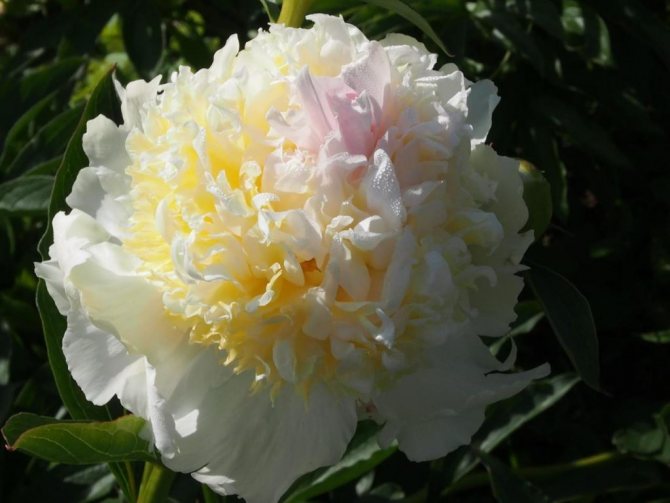

Top breaststroke An interesting variety, the flowers of which have several different shades at once. For example, the most common varieties are those with a pink heart, yellow petals flanking it, and large white ones around the perimeter.
Tall plant, with strong stems up to 120 cm in length. The flowers are large, from 22 cm or more. Each stem can have up to three buds. They bloom in late June and bloom for up to 3 weeks. The aroma is pleasant, average.
They grow both in the sun and in partial shade. Care as for ordinary peonies. Watering is moderate.
back to menu ↑
See also: Garden gerbera: description, species and varieties, planting and caring for an African flower in the open field, reproduction, possible diseases (40+ Photos & Videos)
Maxim festival


Maxim festival Herbaceous peony up to 110 cm tall. Flowers are large, heavy, with a diameter of more than 25 cm. Despite the abundance of flowers and their size, the stems perfectly hold them, doing without additional supports.
The petals are terry, the color is white, only the core has pink or purple edging along the edges. Flowering is one-time, but very effective: due to the large size of the flower and several buds on the stem, sometimes foliage in the upper part of the bush is not visible behind the flowers.
Blooms in mid-summer, flowering duration up to 3 weeks. The foliage retains its decorative effect until late autumn: in September it changes its color to burgundy red.
Grows in light and partial shade. Requires enough moisture, but needs well-drained soil. Otherwise, it is not picky about care, it does almost without additional fertilizing, however, for the winter it is advisable to cover the cut stems with compost.
Prefers neutral soils; acidic require liming. Frost resistance is high, up to -40 ° С.
back to menu ↑
See also: Home flower hippeastrum - a multifaceted hybrid: description, types, care, cultivation, reproduction and other useful information (160 Photos) + Reviews
Highlight
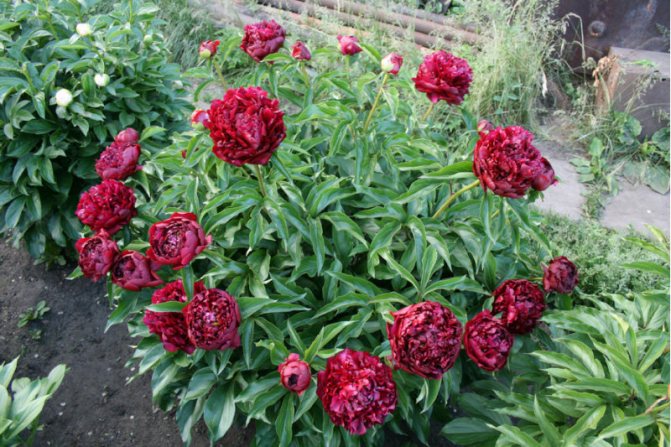

Highlight A rather rare variety, since it has a very dark saturated color. Dense double flowers of almost spherical shape are large (up to 25 cm). During flowering, the color changes slightly - from dark burgundy it becomes almost chocolate.
The height of the stems is about 80-90 cm. The stems are strong, capable of holding up to three giant flowers without props. They have a light pleasant aroma. They bloom relatively late - in mid or late August, bloom up to 3 weeks.
They prefer sunny areas. They need loose soil with good drainage and neutral acidity. Even weak acidity is unacceptable for this variety - liming must be applied. The rest of the requirements for growing are standard.
Homemade peonies: planting and care
A tree peony is transplanted in the fall, at the beginning of September. You can use seeds, but planting the root is more efficient and faster (the seeds must be germinated in advance).
How is the planting process:
- Decide on the landing site, taking into account the above recommendations.
- Dig holes. Their depth should be about 60 cm, width - 80 cm.
- If it is possible to prepare the planting holes in July, then the earth will settle as required.
The next step is to prepare the fertilizer for the soil. At the bottom of each hole, 10 kg of organic fertilizers are placed. Peat, compost, rotten manure will do. If the soil is clayey, then sand should be present in its composition, if, on the contrary, it is sandy, then you need to add clay. Planting a seedling - you need to carefully plant them in the soil without damaging the buds, root, to a depth of 5 cm.


By planting the plant closer to the surface, the possibility of getting the disease is higher.
After laying the seedlings, sprinkle the surface with sand. Then cover with the earth remaining when digging holes. Water the plant immediately.If the climate is dry, then watering should be carried out before the onset of the cold period. For the winter, the plant is covered with compost. Unfortunately, it will not be possible to completely protect decorative flowers from diseases. Why is this happening? The cultivation of a plant is influenced by various pests, external natural and artificial factors.
What diseases can be, and how to deal with them:
- Viruses - transferred from other plants. The most famous of these is the so-called tobacco rattle. Expressed in leaf spots. If you notice the characteristic lines, circles in time, then you can get rid of the virus without harming the plant. Fortunately, peonies do not carry viruses as painfully as lilies or tulips.
- Rust - the appearance of dark brown, brown spots on the surface of the leaves. The disease appears with high humidity in hot climates. Diluted Bordeaux liquid will help fight the disease. Damaged leaves should be removed so that the disease does not spread.
- Gray rot - the most dangerous disease. It affects the whole plant: leaves, flowers, stems. The flower looks wilted, black bloom spreads throughout the plant. It is better to prevent the onset of the disease immediately. Before winter comes the pruning of the stem. In the spring, spray with Bordeaux solution. Already infected areas are cut, the plant is treated with a suspension of Tiram.
- Powdery mildew - Develops a white coating. Does not do much harm to the plant. You can remove it with a solution of soda and laundry soap.
- Mosaic - it is difficult to remove the affected areas here, they can be combined with healthy areas.
You need to be able to distinguish between the last disease: yellow or several tones lighter spots and stripes appear on the leaves. To prevent the mosaic from spreading, in the spring you need to cut off the infected shoots and burn them. Alirin will help from chemicals.
Preparing peonies for winter
The tree peony is resistant to winter frosts, so it is rarely insulated. And yet, if the region is northern, it is better not to risk your favorite plant and prepare it for winter. The first step is to tie the stems and lay a layer of mulch under the bush with a layer of 20-25 cm. Peat is best used as mulch. Then, when frosts have already begun, the bush is covered with spruce branches, burlap hay. You should not cover the bush until frost, otherwise the buds will begin to bloom! With the onset of spring, the plant is freed from the shelter and the pagons are untied.
The tree peony is a beautiful plant with lush blooms and abundant green foliage. It can be used for landscaping the site, flower bed decoration. Often the flowers of this plant are used in the creation of bouquets, because they look spectacular and stand in vases for a long time. Growing this culture is not difficult, the main thing is to properly plant and provide at least minimal care.
Pictures of peonies
All new varieties of peonies are being bred, along with this the palette of their colors is expanding. Even a combined gamut appears. There are peonies 2 and 3 colored, interpreting the color in different ways. A white terry bud can be divided into thin red stripes. Or as if divided into 2 parts of pale pink and light yellow flowers.
Now it is very fashionable to make bouquets from peonies.
The trend has spread rapidly - peonies in a box. It is a stylish and charming gift. Having looked at the best pictures of peonies, you can once again make sure that these are delightful beautiful flowers. The patio is the most popular indoor peony variety.


Their color palette is multifaceted:
- Snow white;
- Red;
- Burgundy;
- Raspberry.
To make the flowering of lush buds happy all year round, indoor peony species were bred. Stores offer a choice of a catalog of indoor peonies. Now you can admire them not only in landscape design. They are smaller but retain their pleasant aroma. You can grow indoor peony using seeds.
Transplanting an adult plant
The tree peony does not tolerate transplanting very well, therefore, unless absolutely necessary, it is better not to resort to such a procedure. If a transplant is nevertheless necessary, the bush is dug in and taken out together with a lump of earth so that the roots remain as intact as possible.
Then they wash off the earth with water, cut off the damaged and too long roots. Places of cuts are moistened with potassium permanganate and charcoal. The prepared plant is transferred to a new location.
A tree-like peony is able to give any personal plot a unique charm and beauty. At the same time, the plant does not require special knowledge and special efforts from the gardener when growing.
Peony varieties
There are 34 types of peonies, several thousand varieties. The tree species alone has 5,000 registered varieties. One can only imagine how long it will take to process this data. For convenience, peonies are divided into 5 main groups.
They have the following names:
- Terry - large petals are located around the inflorescence in a few rows. In this species, the stamens sometimes turn into petals. And in some varieties, they are simply hidden under the petals. Terry has subgroups: crown hemispherical. Early varieties: Torch, Anastasia, Peach in the snow, Robine, Dragon's Gold, Celestial Gold. Terry pink peonies look very beautiful.
- Opposite group – non-double... The petals of a flower are not as densely arranged as in double ones, only in 1 or 2 rows. They are wider and larger. There are few petals, only about 10. The yellow center is open, stamens, pistils are clearly visible (variety - Mrs. Hemerik).
- Japanese Is a symbiosis of double and non-double peony. The core is bright yellow, the stamens have a smooth transition to the petals. There is a feeling as if the petals are growing directly from the stamens. Famous varieties of the Japanese group of peonies: Karara, Pearl placer, Hot chocollet, Twins.
- Anemone - spherical volumetric flowers. The lower petals are wide, forming a basic spherical row. Closer to the center, the petals are much narrower and smaller. Common varieties Snow Mountain, Rhapsody with early stages of flowering.
Semi-double flowers consist of 5-7 dense rows of petals of the same size. Stamens can be located not only in the center, but also between the petals. The group has early varieties of Ann Berry Cousins, Miss America, Lastres.
In conclusion, it should be noted that planting peonies in spring is not worth it. If this is done, then the plants grow poorly and get sick. In the spring, planting can be done at the earliest possible time, as soon as the snow melts.
The most beautiful types of peonies with photos
Summer is often called the most common time for flowering of this type of plant.
Having found several beautiful, lush peony bushes on your site, your mood instantly improves. Such flowers harmoniously complement the dacha, making it a real ball of colors.
In order for the cultivation of peonies to bring only positive emotions, we offer the names of the most beautiful species, which today are popular among the landscape design of flower beds.
Consider:
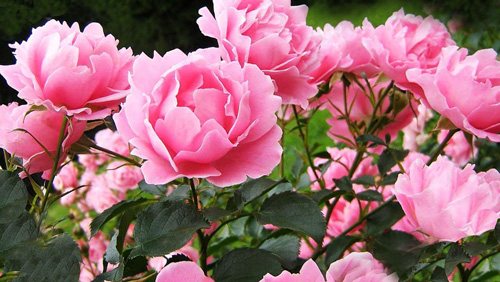

- August Dessert. At first glance, it may seem that this is not a peony at all, but an attractive, aromatic cake with cream. The bud looks so graceful, its scent attracts insects. The stem reaches 80 centimeters in height, and the pink petals are beautifully framed in a thin white thread around the edges.
- Green Halo. This species is suitable for growing in a flower garden, flower bed. The light green shade of the petals will bring joy to the most demanding gardeners. Cactus-shaped, double peony reaches a height of 75 centimeters.
- Walter Maines. This species belongs to the Japanese class, its elegant dark red buds are harmoniously combined with creamy stamens. Maines is considered one of the rare varieties.
- Miss America. One of the representatives of white peonies, the middle of which is filled with yellow stamens.The variety is considered medium early, the plant height reaches 75 centimeters.
- Mirage. The most fragrant type of peonies with purple buds. The middle of the flower is filled with creamy stamens. The bright, lush bloom is accompanied by a strong jasmine scent. Variant is well suited for growing in the park, as a background for flower beds.
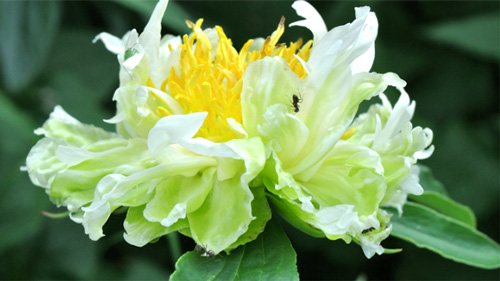

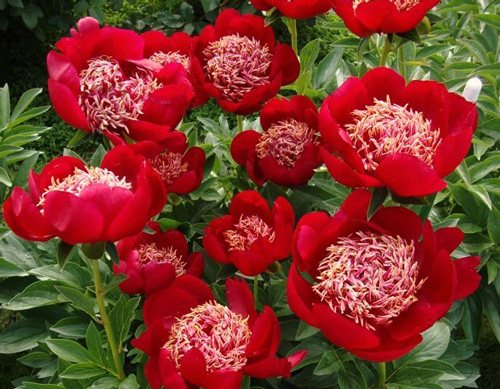

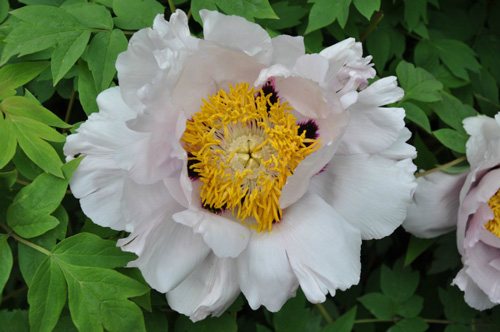

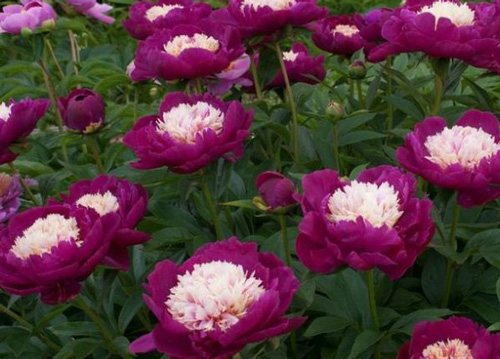

After reading a brief description of each of the most beautiful species, you can safely move on to choosing the best variety of 2020 for the garden and vegetable garden.


